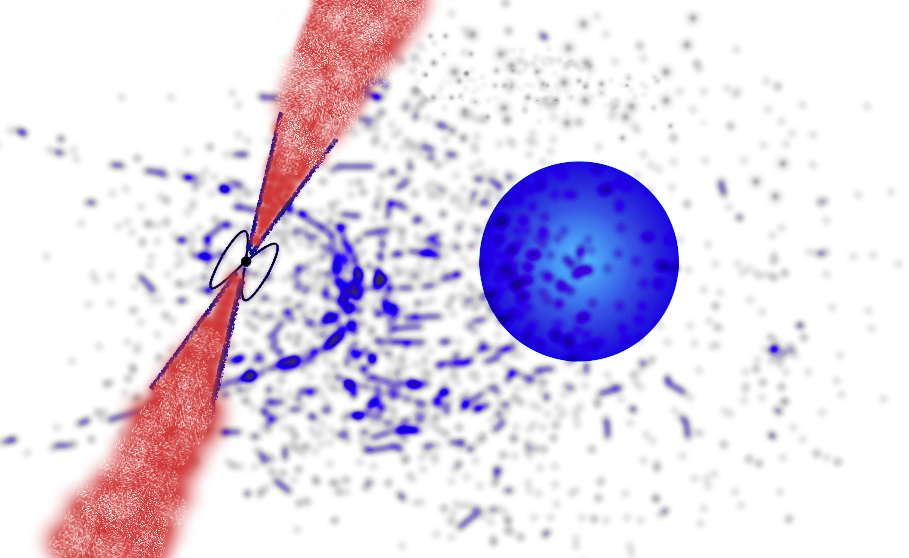
High Mass X-ray Binaries
The study of stars in binaries is a multidisciplinary field with an important impact on different areas of astronomy. A large involvement of our group is in the investigation of all types of High Mass X-ray Binaries (HMXBs).
In a HMXB, a compact object (a neutron star or a black hole) emits X-rays because of the mechanism of accretion: the compact object gravitationally captures material from the massive companion star (mass larger than 10 solar masses). The captured matter falls towards the compact object and its gravitational potential energy is radiated away in X-rays.
There are three main types of HMXBs: the Supergiant Fast X-ray Transients (SFXTs), the classical persistent HMXBs with supergiant companions (SgHMXBs) and the Be X-ray binaries (Be/XRBs).
SFXTs are one of the most spectacular discoveries obtained by the INTEGRAL satellite. They are HMXBs hosting early-type supergiant companions, where the compact object (usually a neutron star) displays an extreme X-ray transient behavior, with a huge range of variability in their X-ray intensity, up to six orders of magnitude between quiescence and outburst. Their luminous X-ray emission is concentrated in short (about one hour) flares (reaching 1e36-1e37 erg/s), belonging to longer (a few days) outbursts. Our investigation is focused in the interpretation of X-ray observations coming from different satellites (from INTEGRAL in the hard X-ray band 20-100 keV to XMM-Newton below 15 keV). Both single, long exposure observations (XMM-Newton, Suzaku, NuSTAR) and monitoring campaings (INTEGRAL, Swift/XRT), allowed us to uncover several SFXT properties, like the fact that these transients spend a large fraction of their life in an intermediate level of X-ray emission (below 1e34 erg/s; Sidoli et al. 2008).
The exploitation of all archival public INTEGRAL observations (see our local archive page at this link) allowed us to estimate their duty cycle (less than 5% of the time is spent in outburst), and to compare their properties with other kinds of HMXB (persistent SgHMXBs and Be/XRBs; Sidoli & Paizis 2018). The SFXT luminosity distributions at hard X-rays (18-50 keV) show a power-law shape (Paizis & Sidoli 2014 ; Sidoli & Paizis 2018), which can be explained by magnetic reconnection at the neutron star magnetosphere (Shakura et al. 2014), in the framework of the quasi-spherical settling accretion, as proposed by Shakura & Postnov (2012; 2017). This regime is able to reduce the accretion rate onto the neutron star most of the time (except during the short X-ray flares). The search for cyclotron lines in SFXT X-ray spectra, to obtain a direct measurement of the neutron star magnetic field, is performed by means of NuSTAR (Sidoli et al. 2017) and INTEGRAL observations .
The study of archival INTEGRAL data of many SFXTs has allowed us to discover for the first time a periodicity in the outburst recurrence from a SFXT, IGR J11215-5952 (Sidoli, Paizis & Mereghetti, 2006). The properties of the X-ray light-curve suggest an alternative outburst mechanism, linked to the presence of a preferential plane for the outflowing supergiant wind, inclined with respect to the orbital plane of the system. The outburst is produced when the neutron star crosses this second wind component (Sidoli et al. 2007). The recent discovery of a kG magnetic field in its supergiant companion confirms our prediction of this focussed, wind component (Hubrig et al. 2018 ).
The systematic analysis of the XMM-Newton archival observations under the EXTraS project (at this link), has allowed us to discover the first accreting neutron star in M31 for which the spin period has been found (P=1.2 s; Esposito et al. 2016), to discover periodic dips in the brightest hard X-ray source of M31 (Marelli et al. 2017), to uncover the properties of the low luminosity flaring state of SFXTs (Sidoli et al. 2019).
Our collaboration with the Chandra ACIS Timing Survey Project (PI G.L. Israel, OA Rome; Israel et al. 2016) in the exploitation of the Chandra archive searching for periodic X-ray signals, led to the discovery of many interesting sources. To name but two examples: the slowest X-ray pulsar (spin period of 10 hours, AX J1910.7+0917; Sidoli et al. 2017 ) and a black hole binary in a 6.4 hours orbit, located in the spiral galaxy NGC 4490 (Esposito et al. 2013).
The high throughput and spectral resolution of XMM-Newton allows us to study in depth the low energy X-ray emission of the Be/XRBs. In this way, it is possible to reveal that the spectrum of these sources is characterized by a clear soft excess compared to the main power-law component. This additional component is pulsed and can be described with a black-body model with different properties along the pulse phase. In the persistent and low-luminosity Be/XRBs observed in our Galaxy ( La Palombara et al. 2012 ), this component is hot (kT > 1 keV) and small (R < 0.5 km), and comes from the polar caps of the accreting neutron star. The situation is different in the case of the high-luminosity transient sources ( La Palombara et al. 2018 ). Interestingly, during Be/XRBs outbursts in sources located in the Small Magellanic Cloud (SMC), the X-ray luminosity can reach 1E38 erg/s and the pulsating black-body component is characterized by low temperature (kT < 0.5 keV) and large size (R ~ 100 km). In this case, the soft excess can be ascribed to the reprocessing of the primary X-ray emission at the inner edge of the accretion disk. Moreover, in these sources it is possible to detect several narrow emission and absorption features, which are the signature of the presence of photo-ionized matter around the accretion region.
The long term aim of our research on all types of HMXBs is to cast light on the accretion mechanism responsible for their different X-ray behaviors and to better understand the role of the wind of the massive donor (Martinez-Nunez et al. 2017).
Gamma-ray Binaries
Within the the Cherenkov Telescope Array collaboration (CTA) and Astri/CTA Data Challenge (ACDC), we are investigating the potential capabilities of CTA and CTA-pathfinder (ASTRI miniarray) on the currently known gamma-ray binaries (e.g. Chernyakova et al. 2019 ).
Low Mass X-ray Binaries
We coordinate multi-wavelength, INTEGRAL-Chandra based, campaigns in order to unveil the nature of newly discovered INTEGRAL sources (e.g. Paizis et al. 2015 ). Among LMXBs, we also deal with the spectral and temporal features of accreting millisecond pulsars (AMXPs). In particular the study of their accretion discs and the relativistic Iron emission lines (6.4-6.9 keV) can give us robust constraints on the accretion mechanisms at play in such systems. Furthermore, the AMXP temporal properties allow us to study the evolution of their spin periods (during accreting and quiescent phases) necessary to constrain (or obtain upper limits) on the NS dipolar magnetic field which is responsible of the mass transport towards the NS polar caps and the disc truncation (e.g. Pintore et al. 2016 ).
Hot subdwarfs in X-ray Binaries
The high sensitivity of current X-ray observatories allows us to study a new class of X-ray binaries in which the mass donor is a hot subdwarf star. Hot subdwarfs are evolved low-mass stars that lost most of their hydrogen envelopes and are now in the stage of helium core burning. A possible mechanism responsible for the loss of the massive H envelopes necessary to form hot subdwarfs is mass transfer in a binary. Evolutionary models predict that many hot subdwarfs should have neutron star or white dwarf companions. X-rays can be used to discover such systems, which are difficult to identify with optical spectroscopic campaigns.
The binary HD 49798, in which the compact companion is the fastest spinning white dwarf known (P=13.2 s) and one of the most massive with a dynamical mass measurement (see this link) is particularly interesting. We recently found that the white dwarf is spinning-up at a rate that cannot be explained by accretion torques, suggesting that this might be the first evidence for the radial contraction of a young white dwarf, predicted by theoretical models but never observed before (see this link). In the course of this project we also firmly established with Chandra, Swift, and XMM-Newton observations that X-ray emission is a common characteristic of hot subdwarfs ( Mereghetti & La Palombara 2016). This emission, seen in non-binary subdwarfs of B and O spectral type, is most likely produced by shock-heated plasma in their stellar winds.
The long term goal of this line of research is to shed light on the poorly known processes taking place during common envelope evolutionary phases and on the properties of the weak stellar winds occurring in the least luminous hot stars.
